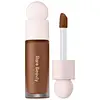What's inside
What's inside
 Key Ingredients
Key Ingredients

 Benefits
Benefits

 Concerns
Concerns

No concerns
 Ingredients Side-by-side
Ingredients Side-by-side

Water
Skin ConditioningDimethicone
EmollientHydrogenated Didecene
Skin ConditioningCetyl PEG/PPG-10/1 Dimethicone
EmulsifyingPropanediol
SolventGlycerin
HumectantAcrylates/Polytrimethylsiloxymethacrylate Copolymer
Skin ConditioningBoron Nitride
AbsorbentPolyglyceryl-4 Isostearate
EmulsifyingTrimethylsiloxysilicate
EmollientIsododecane
EmollientDisodium Stearoyl Glutamate
CleansingDisteardimonium Hectorite
StabilisingHydroxyacetophenone
AntioxidantOryza Sativa Bran Wax
Skin ConditioningSodium Chloride
MaskingDimethicone Crosspolymer
Emulsion StabilisingHelianthus Annuus Seed Oil
EmollientCaprylyl Glycol
Emollient1,2-Hexanediol
Skin ConditioningPhenyl Trimethicone
Skin ConditioningTocopheryl Acetate
AntioxidantAluminum Hydroxide
EmollientTrisodium Ethylenediamine Disuccinate
Dimethiconol
EmollientDecyl Glucoside
CleansingGardenia Florida Fruit Extract
Skin ConditioningHexylene Glycol
EmulsifyingNelumbo Nucifera Flower Extract
Skin ConditioningNymphaea Odorata Root Extract
RefreshingPhenoxyethanol
PreservativeCI 77891
Cosmetic ColorantIron Oxides
Water, Dimethicone, Hydrogenated Didecene, Cetyl PEG/PPG-10/1 Dimethicone, Propanediol, Glycerin, Acrylates/Polytrimethylsiloxymethacrylate Copolymer, Boron Nitride, Polyglyceryl-4 Isostearate, Trimethylsiloxysilicate, Isododecane, Disodium Stearoyl Glutamate, Disteardimonium Hectorite, Hydroxyacetophenone, Oryza Sativa Bran Wax, Sodium Chloride, Dimethicone Crosspolymer, Helianthus Annuus Seed Oil, Caprylyl Glycol, 1,2-Hexanediol, Phenyl Trimethicone, Tocopheryl Acetate, Aluminum Hydroxide, Trisodium Ethylenediamine Disuccinate, Dimethiconol, Decyl Glucoside, Gardenia Florida Fruit Extract, Hexylene Glycol, Nelumbo Nucifera Flower Extract, Nymphaea Odorata Root Extract, Phenoxyethanol, CI 77891, Iron Oxides
Water
Skin ConditioningGlycerin
HumectantPEG-40 Stearate
EmulsifyingCetyl Alcohol
EmollientStearyl Alcohol
EmollientBeta-Sitosterol
Emulsion StabilisingSucrose Stearate
EmollientSucrose Distearate
EmollientCeramide AP
Skin ConditioningCeramide NP
Skin ConditioningCeramide EOP
Skin ConditioningGlyceryl Stearate
EmollientSodium Hyaluronate
HumectantCholesterol
EmollientPolysorbate 20
EmulsifyingDipotassium Phosphate
BufferingSodium Lauroyl Lactylate
EmulsifyingCaprylyl Glycol
EmollientPhenoxyethanol
PreservativeHexylene Glycol
EmulsifyingPhytosphingosine
Skin ConditioningDisodium EDTA
Carbomer
Emulsion StabilisingXanthan Gum
EmulsifyingWater, Glycerin, PEG-40 Stearate, Cetyl Alcohol, Stearyl Alcohol, Beta-Sitosterol, Sucrose Stearate, Sucrose Distearate, Ceramide AP, Ceramide NP, Ceramide EOP, Glyceryl Stearate, Sodium Hyaluronate, Cholesterol, Polysorbate 20, Dipotassium Phosphate, Sodium Lauroyl Lactylate, Caprylyl Glycol, Phenoxyethanol, Hexylene Glycol, Phytosphingosine, Disodium EDTA, Carbomer, Xanthan Gum
 Reviews
Reviews

Ingredients Explained
These ingredients are found in both products.
Ingredients higher up in an ingredient list are typically present in a larger amount.
Caprylyl Glycol is a humectant and emollient, meaning it attracts and preserves moisture.
It is a common ingredient in many products, especially those designed to hydrate skin. The primary benefits are retaining moisture, skin softening, and promoting a healthy skin barrier.
Though Caprylyl Glycol is an alcohol derived from fatty acids, it is not the kind that can dry out skin.
This ingredient is also used as a preservative to extend the life of products. It has slight antimicrobial properties.
Learn more about Caprylyl GlycolGlycerin is already naturally found in your skin. It helps moisturize and protect your skin.
A study from 2016 found glycerin to be more effective as a humectant than AHAs and hyaluronic acid.
As a humectant, it helps the skin stay hydrated by pulling moisture to your skin. The low molecular weight of glycerin allows it to pull moisture into the deeper layers of your skin.
Hydrated skin improves your skin barrier; Your skin barrier helps protect against irritants and bacteria.
Glycerin has also been found to have antimicrobial and antiviral properties. Due to these properties, glycerin is often used in wound and burn treatments.
In cosmetics, glycerin is usually derived from plants such as soybean or palm. However, it can also be sourced from animals, such as tallow or animal fat.
This ingredient is organic, colorless, odorless, and non-toxic.
Glycerin is the name for this ingredient in American English. British English uses Glycerol/Glycerine.
Learn more about GlycerinHexylene Glycol is a surfactant. Glycols are a class of alcohols. Hexylene Glycol is a surfactant and emulsifier.
As a surfactant, Hexylene Glycol helps gather dirt and oil on your skin to be washed away.
As an emulsifier, Hexylene Glycol helps keep water and oil together. This prevents them from separating in a product. Hexylene Glycol also thins out the texture of a product by lessening viscosity.
Hexylene Glycol has a small molecular weight.
Learn more about Hexylene GlycolPhenoxyethanol is a preservative that has germicide, antimicrobial, and aromatic properties. Studies show that phenoxyethanol can prevent microbial growth. By itself, it has a scent that is similar to that of a rose.
It's often used in formulations along with Caprylyl Glycol to preserve the shelf life of products.
Water. It's the most common cosmetic ingredient of all. You'll usually see it at the top of ingredient lists, meaning that it makes up the largest part of the product.
So why is it so popular? Water most often acts as a solvent - this means that it helps dissolve other ingredients into the formulation.
You'll also recognize water as that liquid we all need to stay alive. If you see this, drink a glass of water. Stay hydrated!
Learn more about Water